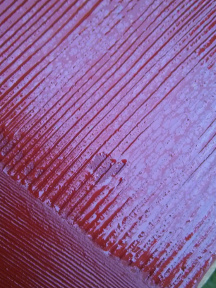Our deck dutch door needed a new coat of paint, and we tried out milk paint. The door was a maroon red, which didn’t match the house that well. We bought a terra cota paint that fit perfectly.
On our first try we painted directly over the latext paint. We used Ultra Bond so the milk paint would stick to the latext paint. We mixed the paint with an egg beater, but it stayed lumpy. There were small clumps of milk protein in the milk paint. We’d hoped they would go away–they didn’t. We ended up picking them off by hand and sanding them lightly between coats.
In the end, the door looked great. The milk paint was a beautiful matte red. However, after about a week the fall dew left a hazy white on the door. Later, splashes of water left marks on the door itself. Before long, it looked awful. Fortunately, after contacting Dwaine from Real Milk Paint, we learned that coating with thinned Tung Oil might mask the spots (and protect the door from the weather). We used Benmatte–it worked great.
Next though, the lowest layer of latex paint started peeling and once again the door looked pretty bad. I chemically stripped the door (a horrible process), sanded lightly with 120 sand paper, and milk painted again. This time we filtered the milk paint through a nylon and it came out perfectly smooth. We applied a coat, waited 2 hours, and then applied another coat, but this time of milk paint with 15% tung oil. The second coat didn’t go on easily. The oil separated from the paint and the paint beaded up and pulled back in areas. Basically the consistency of the paint was ruined–I wouldn’t mix again unless I were trying to save time.

Fortunately, it looked great when dry. We finished with a coat of Benmatte.
